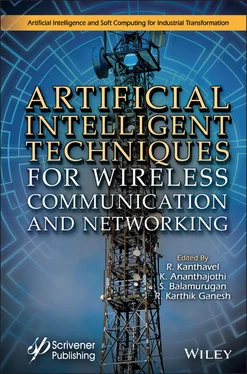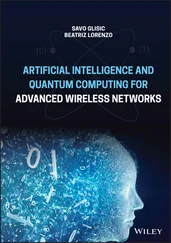Artificial Intelligent Techniques for Wireless Communication and Networking
Здесь есть возможность читать онлайн «Artificial Intelligent Techniques for Wireless Communication and Networking» — ознакомительный отрывок электронной книги совершенно бесплатно, а после прочтения отрывка купить полную версию. В некоторых случаях можно слушать аудио, скачать через торрент в формате fb2 и присутствует краткое содержание. Жанр: unrecognised, на английском языке. Описание произведения, (предисловие) а так же отзывы посетителей доступны на портале библиотеки ЛибКат.
- Название:Artificial Intelligent Techniques for Wireless Communication and Networking
- Автор:
- Жанр:
- Год:неизвестен
- ISBN:нет данных
- Рейтинг книги:5 / 5. Голосов: 1
-
Избранное:Добавить в избранное
- Отзывы:
-
Ваша оценка:
- 100
- 1
- 2
- 3
- 4
- 5
Artificial Intelligent Techniques for Wireless Communication and Networking: краткое содержание, описание и аннотация
Предлагаем к чтению аннотацию, описание, краткое содержание или предисловие (зависит от того, что написал сам автор книги «Artificial Intelligent Techniques for Wireless Communication and Networking»). Если вы не нашли необходимую информацию о книге — напишите в комментариях, мы постараемся отыскать её.
The 20 chapters address AI principles and techniques used in wireless communication and networking and outline their benefit, function, and future role in the field.
Audience
Artificial Intelligent Techniques for Wireless Communication and Networking — читать онлайн ознакомительный отрывок
Ниже представлен текст книги, разбитый по страницам. Система сохранения места последней прочитанной страницы, позволяет с удобством читать онлайн бесплатно книгу «Artificial Intelligent Techniques for Wireless Communication and Networking», без необходимости каждый раз заново искать на чём Вы остановились. Поставьте закладку, и сможете в любой момент перейти на страницу, на которой закончили чтение.
Интервал:
Закладка:
12. Li, R., Zhifeng, Z., Zhou, X., Ding, G., Chen, Y., Zhongyao, W., Zhang, H., Intelligent 5G: When Cellular Networks Meet Artificial Intelligence. IEEE Wireless Commun. , 2–10, 2017. Published in: https://ieeexplore.ieee.org/xpl/RecentIssue.jsp?punumber=7742IEEE Wireless Communications (Volume: 24, https://ieeexplore.ieee.org/xpl/tocresult.jsp?isnumber=8088405(Issue: 5, October 2017).
13. Morocho-Cayamcela, M.E. and Lim, W., Artificial Intelligence in 5G Technology: A Survey. Conference, 860–865, Oct. 2018.
14. Pérez-Romero, J., Sallent, O., Ferrus, R., Agusti, R., Artificial Intelligence-based 5G network capacity planning and operation, Semantic Scholar, https://doi.org/10.1109/ISWCS.2015.7454338246–250, 2015.
15. Ranjani, V. and Sangeetha, S.K.B., Wireless data transmission in ZigBee using indegree and throughput optimization. International Conference on Information Communication and Embedded Systems (ICICES2014) , Chennai, India, pp. 1–5, 2014.
16. Shafin, R., Liu, L., Chandrasekhar, V., Chen, H., Reed, J., Zhang, J., Artificial Intelligence-Enabled Cellular Networks: A Critical Path to Beyond-5G and 6G. IEEE Wireless Commun. , 1–6, 2020. Published in: https://ieeexplore.ieee.org/xpl/RecentIssue.jsp?punumber=7742IEEE Wireless Communications (Volume: 27, https://ieeexplore.ieee.org/xpl/tocresult.jsp?isnumber=9085248(Issue: 2, April 2020)
17. Soldani, D. and Illingworth, S., 5G AI-Enabled Automation , Wiley online Library https://onlinelibrary.wiley.com/doi/abs/10.1002/9781119471509.w5GRef225, 2020.
18. Varga, P., Peto, J., Franko, A. et al. , 5G support for Industrial IoT Applications—Challenges, Solutions, and Research gaps. Sensors (Basel) , 20, 3, 828, 2020.
19. Wang, S., Wang, C.-X., Hong, X., McLaughlin, S., Artificial Intelligence to Manage Network Traffic of 5G Wireless Networks. IEEE Network , 32, 58–64, 2018.
20. Wang, C.-X., Di Renzo, M., Stanczak, S., Wang, S., Larsson, E., Artificial Intelligence Enabled Wireless Networking for 5G and Beyond: Recent Advances and Future Challenges. IEEE Wireless Commun. , 27, 16–23, 2020.
21. Xiaohu, Y., Zhang, C., Tan, X., Jin, S., Wu, H., AI for 5G: Research Directions and Paradigms , Springer Link, Science China Information Sciences, 62, 21301, 2019.
22. Yao, M., Sohul, M., Marojevic, V., Reed, J., Artificial Intelligence Defined 5G Radio Access Networks. IEEE Commun. Mag. , Science China Information Sciences, http://scis.scichina.com/en/2019/021301.pdf, 57, 14–20, 2019.
1 * Corresponding author: siva.saibabu123@gmail.com
2 † Corresponding author: kanandjothime@gmail.com
3
Artificial Intelligence Revolution in Logistics and Supply Chain Management
P.J. Sathish Kumar1*, Ratna Kamala Petla2, K. Elangovan2 and P.G. Kuppusamy2
1 Dept. of CSE, Panimalar Engineering College, Chennai, India
2 Dept. of ECE, Siddharth Institute of Engineering & Technology (Autonomous), Puttur, India
Abstract
With Artificial Intelligence (AI) and Machine Learning (ML), which will further intensify the discrepancy between winners and losers, the logistics and supplies chain business are already changing their face. By removing deep-rooted shortcomings and complexities, artificial intelligence and machine learning provide creativity with insights into all the logistics and supply chain fields that people cannot easily copy on a scale. In the sense of more accurate capacity management, better efficiency, high quality, lower cost and better quality, artificial intelligent systems aim at achieving the efficient optimization expertise necessary in the logistics and supply chains while at the same time promoting safety. We present a brief description of recent developments and some relevant impacts in logistics and supply chain related to artificial intelligence. Since this is becoming a very large and rapidly growing field, we will not explore the entire application landscape, but concentrate primarily on logistics and supply chain related to artificial intelligence. Our goal is threefold: (i) to provide a complete theory behind logistics and supply chain in terms of impacts and trends; (ii) In order to have a future for the company to improve the logistics and the supply chain–automation exploitation.
Keywords:Artificial intelligence, logistics, machine learning, proactive systems, self learning, supply chain
3.1 Introduction
The COVID-19 outbreak, the economic effects of which will continue for months, has severely affected a significant number of global supply chains. Coronaviruses could halve global growth, according to the Organization for Economic Cooperation and Development (OECD), with many industries facing a major drop across-the-board. The country’s quickest economy and other domestic supply chains are declining as the coronavirus is spreading in other Asian countries [19]. As a result, safety precautions aimed at preventing the further spread of the disease, including immigration bans and huge quarantines, have only contributed to the further deterioration and destruction of global supply chains for food retail and medical supplies and the locking of enterprise resource planning [14, 18].
According to the recent International Data Corporation (IDC) digital economy model, more than 50% of the global nominal gross domestic product should be generated by digitally transformed companies prior to 2023. In 2025, Gartner predicted that growth of AI by 2021 would amount to $2.9 billion in market value and will bring in a development time of $6.2 billion to staff by 2011 and will have implemented AI capabilities in at least 90% of new business applications. But many do not fully understand what this is and how it can help improve activities, including the nominal growth, service and risk mitigation, with all their ardour and enthusiasm [1].
In the past ten years, artificial intelligence (AI) ran each day without understanding something, from high-tech laboratories to anything people use. AI serves all sectors, including the supply chain and logistics, in contrast to powering various applications and other digital materials. In reality, many companies have already taken advantage of AI acquisitions. According to the study, artificial intelligence is one of the key areas where businesses, supplier chain and services generate AI investment revenue [9]. With data in supply chains and logistics rising every day, there is an urgent need for innovative processing technology. That is why many businesses, such as machine education, in-depth education and natural linguistic processing, embrace AI-based computer technologies. These strategies facilitate efficient processing of large quantities of data for advanced analysis, the development of a function or event based on the results of the analysis, describing it and performing many other complex parts [18].
An increasing data volume is not the only factor that leads to IA growth. The trend is in fact driven by a number of other main factors, such as computer power and speed, algorithmic advances, and increased access to AI data. The quick production of computers permits companies to use AI in their work, which requires significant developments in power and process performance. One such innovation was, for example, the development of GPUs that expanded the conventional functions of CPUs. An increasing data volume is not the only factor that leads to IA growth. In fact, the pattern depends on many other significant aspects, including machine strength and speed, computational progress and enhanced access to huge data by the AI system. AI requires large quantities to generate and use multiple data rapidly in the supply chain and logistics companies to show its strength. In recent decades, several new forms of data have arisen and are providing comprehensive machine learning algorithms with a significant amount of juice, which have been used for the best use. In recent years, the data have improved and have allowed for patterns to be detected and connections considered hard to discover by people and conventional technology. Smart algorithms, for example, can provide useful statistics, such as the number of trucks available for distribution in advance, so that consumers can understand the cost and estimated time frames for possible deliveries [2].
Читать дальшеИнтервал:
Закладка:
Похожие книги на «Artificial Intelligent Techniques for Wireless Communication and Networking»
Представляем Вашему вниманию похожие книги на «Artificial Intelligent Techniques for Wireless Communication and Networking» списком для выбора. Мы отобрали схожую по названию и смыслу литературу в надежде предоставить читателям больше вариантов отыскать новые, интересные, ещё непрочитанные произведения.
Обсуждение, отзывы о книге «Artificial Intelligent Techniques for Wireless Communication and Networking» и просто собственные мнения читателей. Оставьте ваши комментарии, напишите, что Вы думаете о произведении, его смысле или главных героях. Укажите что конкретно понравилось, а что нет, и почему Вы так считаете.












